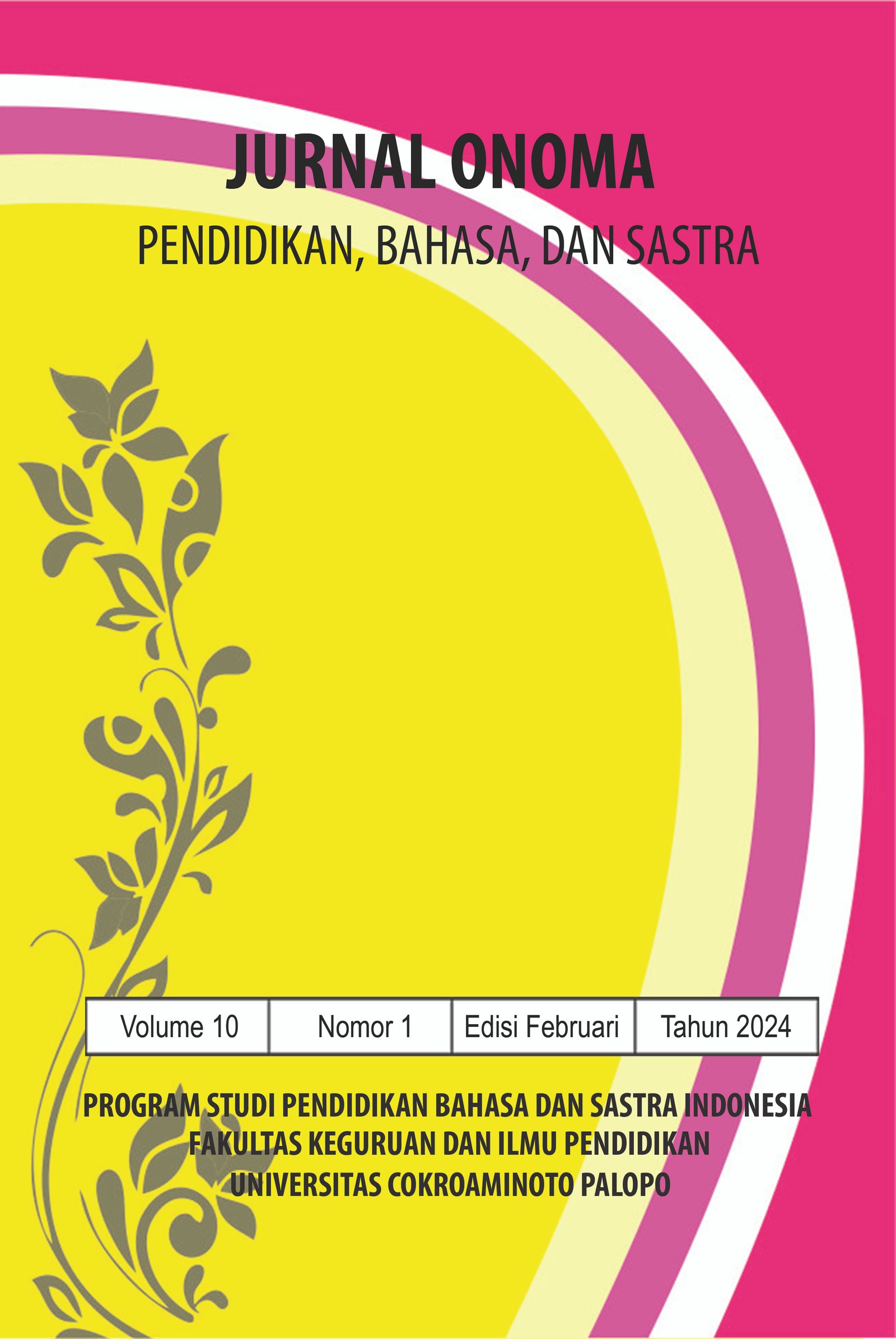Analysis Of Derivational Affixes Found In Sentences Written By The Efl Students Of Tadulako University
https://doi.org/10.30605/onoma.v10i1.3102
Abstract
The objectives of this study were to find out the most dominant and the most difficult function of derivational affixes in the sentences written by the students, and also to know the factor that influences students difficult to use the function of derivational affixes. The design of this study was quantitative descriptive with population were the 5th semester students of English education study program of Tadulako University who have taken the Morphology subject. The sample of this study was 151 students of the 5th semester students used simple random sampling technique. The instruments to collect the data were test and questionnaire. The result of the data analysis show that: (1) the most dominant function of derivational affixes used by the students was verbal suffix –ize that has function to change noun become verb, (2) the most difficult function of derivational affixes used by the students was the suffix -wise as the adverbial suffix that attached to a noun to form an adverb, (3) there were two factors influencing the students difficult in using the function of derivational affixes which was internal factor.
Downloads
References
Anggita, E., Hawa, F., & Lestari, M. Y. (2021). An Analysis of Derivational Affixes Found in the Robin Hood Novel by Henry Gilbert. English Teaching, Literature and Linguistics , 897-910.
Bhardwaj, P. (2019). Types of Sampling in Research. Journal of the Practice of Cardiovascular Sciences, 5(3), 157. https://doi.org/10.4103/jpcs.jpcs_62_19
Creswell, J. W., & Creswell, J. D. (2018). Mixed Methods Procedures. In Research Design: Qualitative, Quantitative, and Mixed Methods Approaches. California: Sage Publications.
Gay, L. R., Mills, G. E., & Airasian, P. (1992). Educational Research: Competencies for Analysis and Applications. Boston: Pearson.
Maharani, & Intan. (2021). The Analysis of Students' Difficulties in using English Affixation . Repositori Institusi Universitas Sumatera Utara, 632-643.
Masitoh, U., & Indriani, L. (2021). An Analysis of Derivational Suffixes on "Percy Jackson the Sea Monster" Novel by Rick Riordan. English Journal of Indragiri: Studies in Education, Literature, and Linguistics, 5(2), 252-272.
Nisa, B. (2020). A Morphological Process of Derivational Affixes in Popular LINE Webtoon: The Annarasumanara. REiLA : Journal of Research and Innovation in Language, 2(2), 85–92. https://doi.org/10.31849/reila.v2i2.4656
Putri, S. H., Basri, H., Syafar, A., Darmawan, Kamaruddin, A., & Suriaman, A. (2021). An Analysis of Derivational Suffixes Found in Reading Texts of English Textbook. Jurnal Kreatif Online, 9(2), 72-83.
Simaremare, D., & Silalahi, D. E. (2021). Derivational Affixes in Writing Analytical Exposition Text. Journal of Languages and Language Teaching, 9(1), 44. https://doi.org/10.33394/jollt.v9i1.2999
Sumual, M. S., Arifin, M. B., & Valientien, N. M. (2021). An Analysis of Derivational Affixes in the Avengers Movie. Ilmu Budaya Jurnal Bahasa, Sastra, Seni, dan Budaya, 5(4), 634-644.
Wibowo, F. E., & Rismawati, E. (2022). An Analysis of Inflectional and Derivational Affixes of the Students' Text. Professional Journal of English Education, 5(6), 1187-1199.
Downloads
Published
How to Cite
License
In submitting the manuscript to the journal, the authors certify that:
- They are authorized by their co-authors to enter into these arrangements.
- The work described has not been formally published before, except in the form of an abstract or as part of a published lecture, review, thesis, or overlay journal.
- That it is not under consideration for publication elsewhere,
- That its publication has been approved by all the author(s) and by the responsible authorities – tacitly or explicitly – of the institutes where the work has been carried out.
- They secure the right to reproduce any material that has already been published or copyrighted elsewhere.
- They agree to the following license and copyright agreement.
License and Copyright Agreement
Authors who publish with Onoma Journal: Education, Languages??, and Literature agree to the following terms:
- Authors retain copyright and grant the journal right of first publication with the work simultaneously licensed under Creative Commons Attribution License (CC BY 4.0) that allows others to share the work with an acknowledgment of the work's authorship and initial publication in this journal.
- Authors are able to enter into separate, additional contractual arrangements for the non-exclusive distribution of the journal's published version of the work (e.g., post it to an institutional repository or publish it in a book), with an acknowledgment of its initial publication in this journal.
- Authors are permitted and encouraged to post their work online (e.g., in institutional repositories or on their website) prior to and during the submission process, as it can lead to productive exchanges, as well as earlier and greater citation of published work.

















